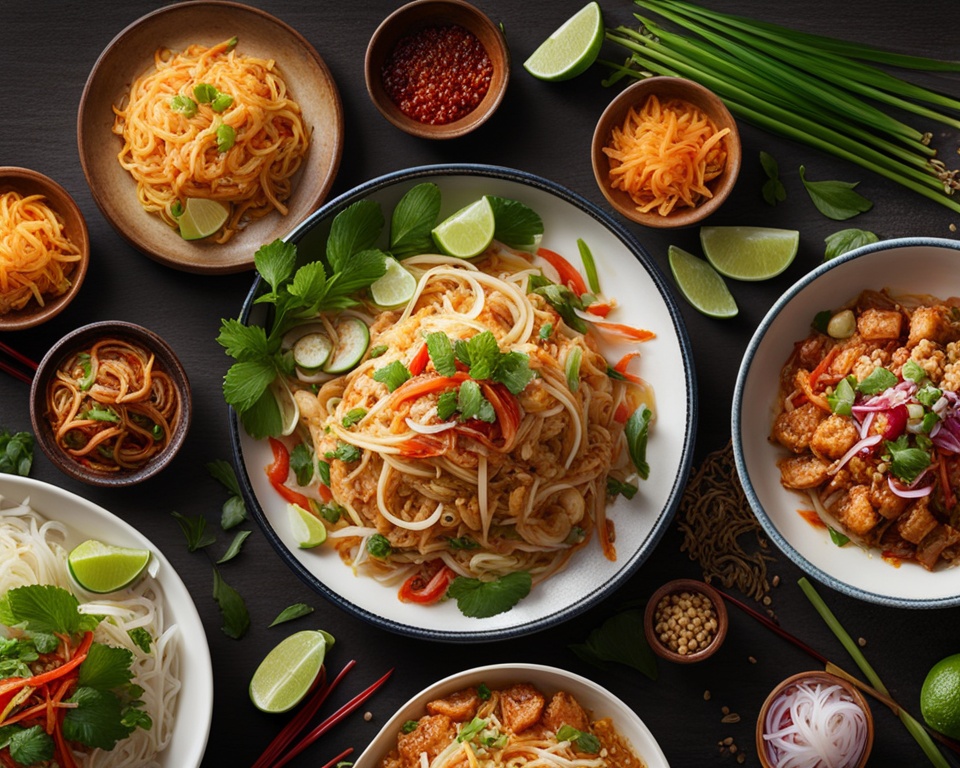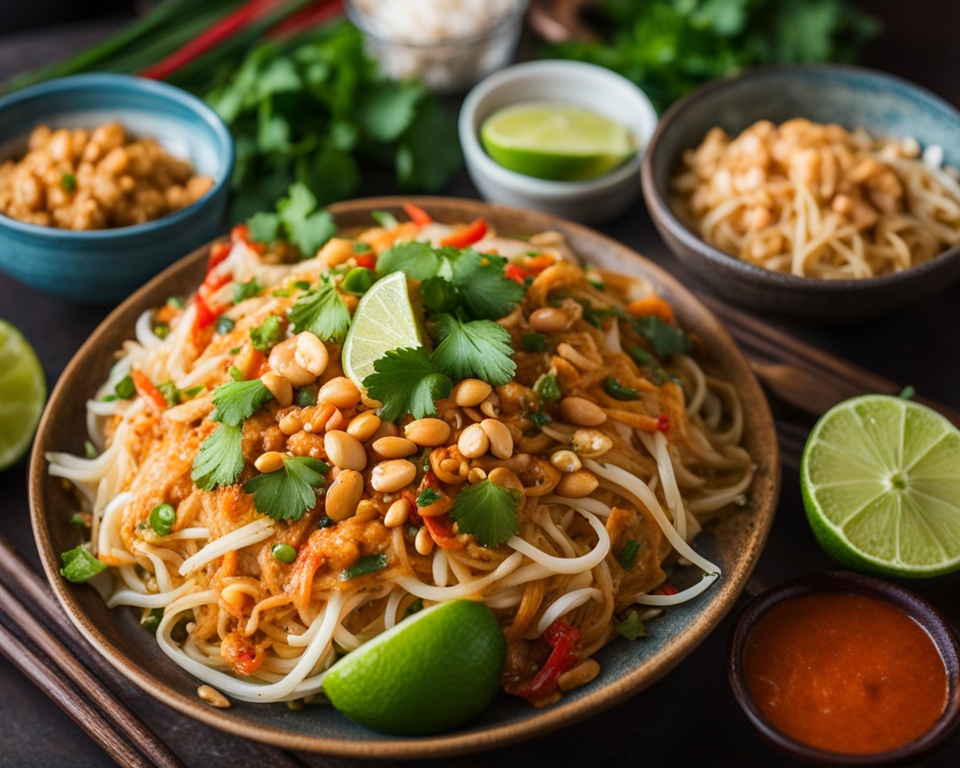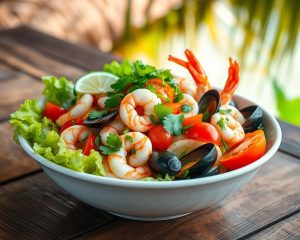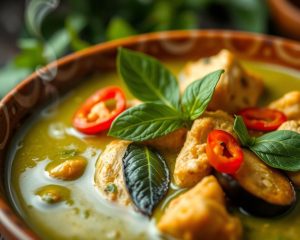
Pad Thai is a famous Thai noodle dish known worldwide. It blends rice noodles, shrimp, and crushed peanuts. Add a mix of aromatic flavors, and you get a taste sensation. This dish showcases Thailand’s rich culture and food skills.
Learn about Pad Thai’s origins, ingredients, and how it’s made. Taste the sweet, sour, and savory flavors that make Pad Thai special. See how different regions add their own twists, showing Thai cuisine’s variety. Whether you’re new to Pad Thai or already love it, this journey through authentic Thai food promises to be exciting.
Read more interesting information at ::102aoki
The Origins of Pad Thai
Pad Thai is a famous noodle dish in Thailand. Its story goes back to the 1930s. The Thai government made it a symbol of their culture. This move helped Pad Thai find its place in Thai cuisine and life.
The Origins of Pad Thai
Its beginnings merge flavors from China and Vietnam. Stir-frying, from Chinese cooking, and the choice of rice noodles show this. These influences show how Pad Thai came to be.
Pad Thai’s source is not clearly pinpointed. However, it’s agreed that it grew from noodles loved in Thailand and its neighbors. Thai cooking styles and the vibrant Bangkok street food scene shaped the dish into what it is today.
Pad Thai is now a key part of Thailand’s food culture. It mixes traditional tastes and modern ways. This fusion has made Pad Thai a dish loved worldwide.
Chinese and Vietnamese Food’s Impact
Pad Thai’s creation owes much to China and Vietnam. For example, the use of rice noodles points to their wide use. They’re common in Thai cooking and Vietnam’s dishes.
In the same way, Pad Thai’s stir-fry method is from China. It came to Thailand through cultural sharing. These combined influences give Pad Thai its special taste and texture.
“Pad Thai is a true testament to the richness and diversity of Thai cuisine, reflecting the country’s long history of culinary exchange and innovation.”
Pad Thai Food: A Culinary Masterpiece
Pad Thai, the iconic asian noodle dishes of Thailand, is a culinary masterpiece. It’s a authentic thai recipes with a blend of flavors and textures. This makes it very popular among lovers of thai cuisine worldwide.
Exploring the Flavors and Textures
Pad Thai is all about balance. It mixes sweet, sour, salty, and sometimes spicy tastes perfectly. Chewy rice noodles form the base, while bean sprouts and roasted peanuts give a great crunch.
Tamarind, fish sauce, brown sugar, and lime juice are the secret ingredients. They combine to create a rich, satisfying flavor. You might find shrimp, chicken, or tofu in it, which adds a lot of protein.
“Pad Thai is a symphony of flavors and textures, a true culinary masterpiece that showcases the best of thai cuisine.”
Pad Thai looks as good as it tastes. The dish is full of vibrant colors and artful arrangements. Scenes like the green bean sprouts and the red dried chilies are quite common in Pad Thai. Every part of the dish is made to please the eyes.
Eating Pad Thai in a street stall or at home both capture the real asian noodle dishes feel. It brings out the authentic thai recipes and shows the depth of Thailand’s culinary heritage.
Essential Ingredients in Authentic Pad Thai
Pad Thai is known for its tasty flavors and unique textures. The dish shines because of a few important items. These create the genuine taste of Thailand we all love.
Rice Noodles: The Foundation of the Dish
Rice noodles are the base of Pad Thai. They are thin and soft, perfect for holding the dish’s rich flavors. Made from the best rice fields of Thailand, they give the meal a special chewy feel.
Shrimp, Chicken, or Tofu: Protein Options
Traditional Pad Thai often features shrimp. Yet, chicken or tofu work well too. This protein choice adds richness and variety. They go great with the rice noodle dishes and authentic Thai recipes.
In addition to noodles and protein, key Thai flavors and ingredients are crucial. Tamarind, fish sauce, sugar, and eggs are a must. They combine to make the sweet, sour, and umami tastes of true Pad Thai.
Choosing and combining these vital elements lets anyone make delicious Pad Thai. It brings a piece of Thailand to your dinner table. With each bite, you taste the authentic flavors.
Pad Thai Sauce: The Key to Authentic Flavor
The Pad Thai sauce is at the core of the popular Thai dish, Pad Thai. It’s a mix of special ingredients that gives Pad Thai its unique taste. These elements create a blend that’s not just sweet, sour, and salty. They’re also what makes this noodle dish so hard to resist.
The Pad Thai sauce is made from a mix of Thai flavors and ingredients. These include the sweet-sour taste of tamarind. Then, there’s the fish sauce that adds a deep and rich flavor. And let’s not forget about palm sugar. It brings a hint of sweet caramel to the sauce.
But making the perfect Pad Thai sauce is not just about adding these ingredients together. It’s about using special Thai cooking techniques. These methods, learned over generations, are what really make the sauce stand out. It’s a refined art, where every flavor needs to be just right. This creates a taste that truly captures authentic Thai cuisine.
“The Pad Thai sauce is the heartbeat of the dish, pulsing with the essence of Thailand’s vibrant culinary heritage.”
How the sauce is prepared is also key to its delicious taste. It’s a step-by-step process that brings out the best of sweet, sour, and salty flavors. Simmering, reducing, and balancing the sauce make these flavors dance together.
The final Pad Thai sauce pulls the whole dish together. It turns simple rice noodles, proteins, and veggies into a flurry of Thai flavors and textures. This sauce represents the heart of genuine Pad Thai. It speaks of Thailand’s amazing food traditions with every bite.
Cooking Techniques for Perfect Pad Thai
To make the perfect Pad Thai dish, learn the stir-frying art. It’s a Thai cooking style that uses high heat. This quickly cooks the noodles and other ingredients. Knowing how to do this lets you make Pad Thai at home that tastes just like the real thing.
Stir-Frying: The Art of High-Heat Cooking
The secret to great Pad Thai is stir-frying. This quick, hot cooking keeps the noodles just right and cooks other parts perfectly. You get to enjoy bright, fresh ingredients.
- Prepare all ingredients before you start: Cut, slice, and measure everything. This makes the stir-frying part smooth and fast.
- Use a wok or big skillet: A wok’s shape or a skillet’s size is perfect for the high heat. It also helps with the stir-frying motion.
- Heat the wok or skillet very well: It should be very hot before you add anything. This is how to get even, fast cooking.
- Add oil and coat the pan: Pick an oil that can take high temperatures, like vegetable or peanut oil.
- Put ingredients in the right order: First goes in the protein, then the vegetables, and at last, noodles and sauce. Doing this helps each part cook as it should.
- Keep tossing everything: Stir continuously to avoid burning. This step is key for a great Pad Thai taste.
With practice, you can cook authentic Pad Thai. It will have the classic wok flavor and just-right texture.
“The secret to real Pad Thai is in the stir-fry. The heat and motion of the wok make the flavors and textures perfect.”
By using these Thai stir-fry methods, you can make your Pad Thai outstanding. It will be a dish everyone remembers and loves.
Regional Variations of Pad Thai Food
While Pad Thai is a key part of Thai cuisine, many parts of Thailand have their own take on it. The bustling Bangkok street food scene and the unique tastes of the north and south add special flavors to this famous noodle dish.
Exploring the Diversity of Thai Cuisine
In northern Thailand, Pad Thai might be different. It could use thicker, wider noodles and a sauce with extra soy sauce and tamarind. The south is famous for adding more seafood like shrimp and squid, giving it a special sea taste.
The exciting street food in Bangkok also influences Pad Thai. Local vendors often add special ingredients to make their own versions. This shows how diverse and creative Thai cuisine can be.
“Pad Thai is not just a single dish, but a canvas upon which the diverse flavors and culinary traditions of Thailand are expressed.”
As you travel through Thailand, each place you visit gives you a unique Pad Thai experience. This shows how rich and varied the country’s food culture is.

Each version of Pad Thai uses special local ingredients and cooking styles. This shows the diversity and creativity of Thai cuisine. Pad Thai is just one example of Thailand’s rich and varied food scene.
Pad Thai: A Street Food Classic
Thailand’s bustling street food scene has made Pad Thai a favorite. It’s known across the country, especially in Bangkok. For years, vendors have cooked and sold this tasty noodle dish, making it a must-try street food.
The Vibrant Street Food Culture of Thailand
Thailand’s street food is a major part of its food culture. It’s easy to find, from busy streets to crowded markets. Pad Thai is a great example, mixing sweet, sour, and savory tastes perfectly.
At Bangkok’s street food markets, you can watch chefs make Pad Thai. Their quick, skillful moves in the open air are a big part of enjoying the dish. It’s an exciting scene, just a few steps from the city’s noise.
Pad Thai is loved not only in Thailand but also around the world. Still, its true magic shows in Thailand’s street food areas. There, it highlights the deep food traditions and culture of the country.
“Pad Thai is more than just a dish – it’s a reflection of the vibrant, communal spirit that defines Thailand’s street food culture.”
| Top Street Food Destinations in Thailand | Signature Pad Thai Dishes |
|---|---|
|
|
Vegetarian and Vegan Pad Thai Options
Thai flavors and ingredients are great for vegetarians and vegans. You can swap out the usual protein with tofu. Or, skip the animal products completely. This way, you still get to savor the amazing taste of pad thai.
For vegetarians, swap the shrimp or chicken for firm tofu. This gives you a tasty plant-based protein. You can cook the tofu to make it crispy, adding texture. Or try mixing in some veggies like carrots or peanuts for a crunchy twist.
To veganize your pad thai, just leave out the egg and any animal ingredients. Instead, use a vegan pad thai sauce. This sauce is made from soy sauce, vinegar, tamarind, and something sweet. It goes perfectly with rice noodles, tofu, and veggies. Together, they make a delicious dish that feels straight from Thailand.
If you’re vegetarian or vegan, or just love Thai flavors and ingredients, try these pad thai recipes. They offer a fun and yummy way to enjoy this Asian noodle dish.
| Ingredient | Vegetarian Pad Thai | Vegan Pad Thai |
|---|---|---|
| Protein | Tofu | Tofu |
| Sauce | Vegetarian pad thai sauce | Vegan pad thai sauce |
| Eggs | Included | Omitted |
| Other Ingredients | Rice noodles, vegetables, crushed peanuts | Rice noodles, vegetables |
“Pad thai is a beloved dish that can be enjoyed by everyone, regardless of dietary preferences. With a few simple substitutions, vegetarians and vegans can savor the authentic flavors of this Thai classic.”
Serving and Garnishing Pad Thai
When it comes to your Pad Thai, how you serve and garnish it makes a big difference. Tend to the plating and mix in colorful garnishes. You’ll turn basic Pad Thai into a work of art.
Arranging the Noodles
The core of Pad Thai is its rice noodles. Place them on the plate thoughtfully. You might twist them into a circle or lay them out like a nest. Whatever you choose, make them look natural on the plate.
Vibrant Garnishes
Authentic Thai recipes shine with the right fresh garnishes. Adding colorful and varied textures can really boost your Pad Thai. Here are some top garnishes to consider:
- Freshly chopped cilantro
- Crushed peanuts
- Sliced green onions
- Lime wedges
- Bean sprouts
These additions both look good and taste good with the noodles. They add zing to the rich, sweet Pad Thai seasoning.
Plating Techniques
Plating your Pad Thai skillfully can add a lot to its look. Try laying out the noodles and toppings neatly. For an extra touch, pour the sauce in a nice way so it covers the dish’s sides. Then, sprinkle the toppings all over the top.
By focusing on how you present and garnish your Asian noodle dishes, the Pad Thai will be memorable. Your guests will love the authentic Thai cuisine experience.
Pairing Pad Thai with Beverages
Thai Pad Thai loves a good companion from the drink world. Its mix of tastes pairs well with beverages that offer a fresh or complementary twist. This combo creates a meal where every bite and sip are a treat for the senses.
The classic Thai iced tea is a top pick to have with Pad Thai. It’s rich, creamy, and a bit sweet. Its contrast with Pad Thai’s savory and tangy flavors is just right. The tea’s cooling effect balances out Pad Thai’s warm kick perfectly.
Looking for something cold and crisp? Try icy cold beer. The beer’s bitterness and fizz can lighten the Pad Thai’s rich flavors. It refreshes your taste buds, getting you ready for more Pad Thai goodness. Many Asian-style beers especially go well with this dish.
If alcohol isn’t your thing, why not have fresh fruit juice or a coconut water? Their natural sweetness and hint of sour offer a lovely contrast to Pad Thai. It’s a perfect non-alcoholic way to enjoy your meal.
| Beverage | Flavor Profile | Pairing Notes |
|---|---|---|
| Thai Iced Tea | Rich, creamy, slightly sweet | Provides a cooling contrast to the savory and tangy Pad Thai |
| Asian-style Beer | Crisp, light, slightly bitter | Cleanses the palate and complements the richness of the dish |
| Fresh Fruit Juice | Sweet, acidic, refreshing | Balances the salty, sour, and umami flavors of Pad Thai |
| Coconut Water | Refreshing, lightly sweet | Provides a hydrating and complementary pairing |
There are many drinks that go well with Pad Thai. Exploring them can really boost your mealtime joy. Plus, you might just find the perfect match that makes your Thai cuisine experience even better.
Pad Thai Food in Thai Cuisine and Culture
Thai cuisine is known for its rich, flavorful foods. Pad thai is a famous, well-loved Thai dish. It shows Thailand’s diverse food traditions and the importance of noodles in their meals.
The Significance of Noodle Dishes in Thailand
Noodle dishes are key in Thai culture and food. They give a filling, satisfying meal and highlight the nation’s many food influences. From the khanom chin in the north to the kuay teow in the center, noodles define Thai food.
Pad thai is a great mix of sweet, sour, and savory tastes. It’s a fine example of Thai cooking skills through the ages. This dish introduces people worldwide to the lively, varied Thai food culture.
“Noodles in Thailand are not just food – they are a cultural symbol, cherishing the country’s food traditions.”
Noodle dishes are everywhere in Thailand, from street stalls to fancy restaurants. Pad Thai is now a key part of the culinary adventure in Thailand. It goes beyond just being a dish; it represents Thailand’s colorful food scene.
Thai food continues to win hearts around the world. Pad thai and other noodle dishes are at the center of this love. They show the depth and beauty of Thai cuisine.
Mastering the Art of Pad Thai at Home
Home cooks love to make the amazing tastes of Thai cooking techniques and Asian noodle dishes. Learning to cook authentic Thai recipes for Pad Thai is fun. Just use the right ingredients and follow the steps carefully.
Stir-Frying for Flavor and Texture
A great Pad Thai starts with stir-frying. Cook everything quickly on high heat for that wok-fried taste. It’s important to stir a lot. This keeps everything cooking evenly and stops the noodles from sticking.
Balancing the Pad Thai Sauce
The sauce is where you mix sweet, sour, and savory perfectly. Finding the right mix of fish sauce, tamarind, sugar, and lime is key. It’s what makes Pad Thai so delicious.
Assembling the Final Masterpiece
Putting Pad Thai together is an art itself. Mixing the noodles with sauce and adding toppings like herbs and peanuts makes it perfect. Each part adds to how good it looks and tastes.
With some practice, anyone can make amazing Pad Thai at home. This lets you enjoy Thailand’s street food flavors without leaving your kitchen.

“Pad Thai is not just a dish, it’s a symphony of flavors that transports you to the bustling streets of Thailand.”
Conclusion
The journey through Pad Thai has shown us its deep meaning and taste. This Thai noodle dish started small but is loved worldwide. We have learned about its key parts, how it’s made, and different versions.
Saying goodbye to Pad Thai shows us how special it is to food enthusiasts. People enjoy Pad Thai everywhere, from Thailand’s streets to their home kitchens. It brings us together with its authentic flavors.
Exploring Pad Thai has been amazing, showing us its cultural significance. Understanding Pad Thai helps us love Thai cuisine more. Let’s keep enjoying Pad Thai, making it a part of our global food culture for the future.






